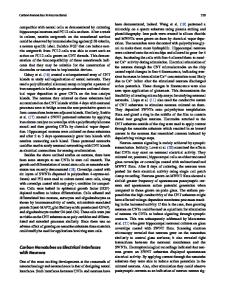Carbon Nanotubes under Bending Strain
- PDF / 6,806,903 Bytes
- 6 Pages / 595 x 842 pts (A4) Page_size
- 13 Downloads / 327 Views
Carbon Nanotubes under Bending Strain
M. Huhtala, A. Kuronen, and K. Kaski Helsinki University of Technology, Laboratory of Computational Engineering P.O.Box 9400, FIN-02015 HUT, FINLAND
ABSTRACT Bending induced deformations in single walled carbon nanotubes with zigzag and armchair chirality have been studied computationally using a classical molecular dynamics simulation method. In this the interatomic forces have been described with Brenner’s empirical model potential. The results given by this classical model have been assessed by letting the most critical, i.e. the most deformed part, of the nanotube further relax by using a dynamical tight binding simulation method. We find that the empirical potential based approach and the tight binding method reproduce similar deformation patterns when the deformation remains relatively small but at higher levels of deformation the results differ significantly. These comparative simulations indicate that graphene interlayer interaction is an important factor in the behavior of deformed nanotubes. INTRODUCTION Carbon nanotubes are thin molecular wires that exhibit interesting physical properties [1]. Thus they have recently roused a lot of interest in the materials research community. The dimensions of these tubes which are at nanometer scale have ensured that much of this interest can be concretized as computational research. In the computational approach the bottleneck is the model of interactions between constituent atoms of the system – a too simple model might not be able to reproduce the behavior of the system accurately, while a more complicated model might be computationally unachievable. In this work we compare two interaction models of different complexity in the context of simulating the bending of carbon nanotubes of different chirality. This we have done by using an empirical interaction model between carbon atoms [2] in the Molecular Dynamics (MD) simulation scheme and compare the results with those obtained by employing a dynamical Tight Binding (TB) scheme [3] on the most critical parts of the bent structure. Nanotube bending was chosen as the topic for the work because structural distortions of different magnitude, and thus of different complexity for the interaction model, can be expected [4–6]. Induced deformations, like local bends, have also been demonstrated to be a way to produce nanoelectronic devices [7–9]. This is due to changes in the conductivity properties of the tube under bending [5, 6, 9–11].
Z9.8.1
SIMULATION METHODS In this work we have employed two different simulation methods. Large scale bending has been performed using a classical molecular dynamics method, where the atomic interactions are described with the potential energy function of the form of a reactive empirical bond-order hydro-carbon potential formulated by Brenner [2]. The second simulation method, a tight binding method by Frauenheim et al., is described in Ref. [3]. The tight binding method is used to evaluate the performance of the classical method by focusing on a sma
Data Loading...










